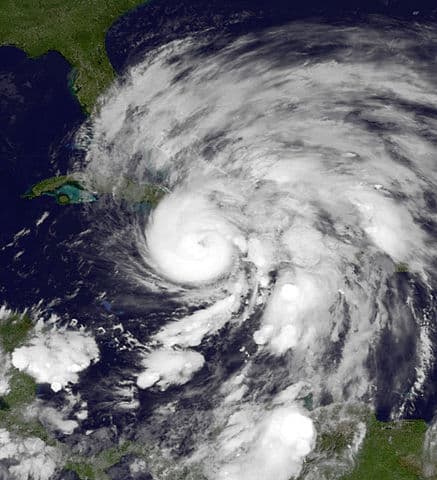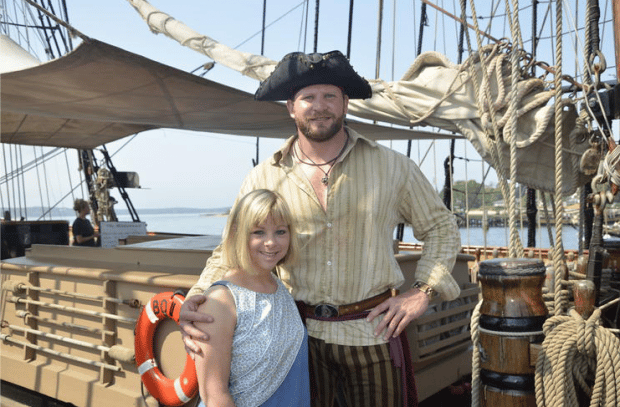
Bounty during Sandy
For the Atlantic coast of the United States, Hurricane Sandy was the biggest hurricane event in years. Luckily for me, it blew past the Chesapeake with minimal damage. But hurricanes tend to write their own stories, and often enough it is the story of a ship that didn’t make it. Such was the fate of the HMS Bounty, a tall ship replica that got caught by Sandy east of Cape Fear, and drowned. The Bounty and her fate became one of electric stories of Hurricane Sandy, and , tragically, she took her captain, Robin Walbridge, and a member of the crew, Claudene Christian, with her. The aftermath? Two dead, and lots of questions about how the Bounty ended up where she was.
Sailors love to second guess, particularly from the comfort of a barstool. But every sailor who has been through a major storm, or near-disaster at sea, knows that there are a million little things that anyone who wasn’t there can’t know. And they know how the best of intentions, and the best of decisions, can still land you in peril. That’s why the sea is the sea. That’s why it is a force, and an irresistible challenge. Having once sailed through the tail end of Hurricane Mitch, which claimed its own Bounty in the form of a tall ship called the Fantome, I tried to let the survivors do their own second-guessing. But it quickly became apparent that the Bounty, under the guidance of Walbridge, had knowingly set sail into the brunt of the hurricane. That is a decision that no sailor can avoid second-guessing. The only mystery was: Why?
The Coast Guard is currently conducting a hearing into Bounty‘s loss, and lots of interesting testimony is being aired. But I also urge you to read the detailed investigative piece in my favorite (non-sailing) magazine, Outside. Written by Kathryn Miles (who is live-tweeting the Coast Guard hearing), it drills deep into the Bounty‘s seaworthiness, the chain of events that led to the sinking, and–this is the big one–the reason Walbridge may have put to sea despite the likely encounter with Sandy.
Everyone can understand bad luck with weather, and how slow boats–despite modern weather forecasting–can sometimes get caught by a fast storm. But Walbridge’s decision to leave port, despite a solid forecast and foreknowledge of a massive storm area, is what makes this tragedy tragically different. A captain’s most sacred responsibility is to look after his ship and his crew. In this case, Walbridge did the opposite. He knowingly put his crew at risk because he felt a need to get the Bounty south. In fact, he called a crew meeting to make clear that anyone who was uncomfortable with the idea of taking a leaky, wooden ship into a storm was welcome to disembark.
That is called hubris (and a lot of other things). And the sense that Walbridge was being cavalier in his thinking was only reinforced in the immediate aftermath of Bounty‘s loss, when a video interview, in which he talked about chasing hurricanes, popped up on the internet.
As Miles makes clear in her story, Walbridge’s strategy for dealing with Sandy (he told the crew they would sail east until the storm advanced and then loop around the supposedly safer backside) was flawed. Apart from the debatable proposition that the southeast quadrant of a hurricane is safer, forecasts showed Sandy’s strongest winds were where Walbridge proposed to go. Worse, he didn’t even really follow his own strategy, sailing much more directly south than he had proposed, which took him more directly into Sandy’s path, and then turning toward Hatteras and the Gulf Stream (which is just about the worst place you could be in hurricane northerlies).
Author Miles quotes Jan Miles, skipper of the Pride Of Baltimore II and a friend of Walbridge, who calls Walbridge’s entire plan “so amateurish as to be off the scale,” and goes on to say: “It was recklessly poor judgment to have done anything but find a heavy-weather berth for your ship, rather than instead intentionally navigate directly toward Sandy.”
Walbridge’s hurricane management, especially while at sea, infuriated other mariners because you don’t take those sorts of risks unless you are George Clooney with a hold full of fish and a broken freezer, or there is some sort of emergency where lives are clearly at stake.
Here’s author Miles in Outside (Simonin helped administer the Bounty foundation, and was the point of contact ashore):
“The AIS records of the Atlantic during those hours are chilling: a sparsely dotted screen of vessels all making their way to port. Simonin attempted to counter growing vitriol online by reminding mariners of the adage that a ship is safer at sea than at port, but that idea was quickly denounced by other captains. Navy vessels and tankers may go to sea, they responded, but only in the interest of national security or averting major environmental disasters. Did Simonin think either applied to the Bounty? She didn’t reply.”

What follows is predictable: injuries, chaos, equipment trouble, flooding, death. Apart from the hubris or idiocy of taking ANY small sailing ship into a hurricane on purpose, the Bounty, a leaky, aging, wooden vessel, was spectacularly unfit for the challenge.
And that all goes back to the captain, Walbridge. So beyond a certain whiff of arrogance regarding hurricanes, why did Walbridge see the need to put his ship, and his crew, at risk. Until the Coast Guard investigation and any lawsuits are completed, we may not know for sure. But Miles and Outside suggest one possibility, a new partnership Walbridge and Bounty appear to have struck up with Ashley DeRamus, a 30-year-old woman with Down syndrome, and her foundation:
“The plan was for Ashley, and others, to crew again on the ship, starting in St. Petersburg the weekend of November 9. To launch the venture, Kannegiesser was arranging to fly in several children with Down’s, and the Down Syndrome Network of Tampa Bay confirmed that it would be inviting some 400 families with Down’s children to the event. Ashley would recite the Pledge of Allegiance, kicking off the Bounty‘s new chapter as a place of learning and inspiration.
From St. Petersburg, Ashley (below) and several others with Down syndrome would sail with the ship to Galveston, Texas, arriving by her birthday, December 9. Over the winter, Christian would work with them as the Bounty was modified to accommodate special-needs crew. As the summer season got under way, the foundation would pay for other kids with Down’s to join each leg as crew. In 2014, they hoped to attempt the first-ever tall-ship voyage through the Northwest Passage, again with special-needs people among the crew.”

So it could all come down to mundane scheduling, and a captain and ship that had somewhere to be. The potential partnership is laudable, and Walbridge had a history of using the Bounty well for education and inspiration, and infecting visitors with the spirit and excitement of sailing the sea. But it is not nearly enough to justify challenging a hurricane and imperiling a crew. And, yes, that is indeed second-guessing.









